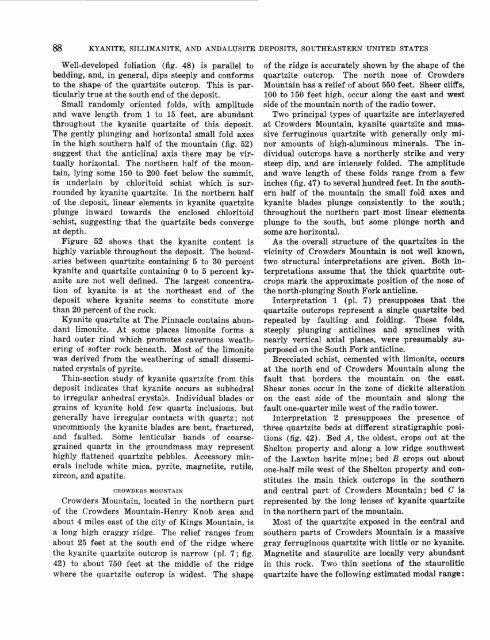Kyanite, Sillimanite, and Andalusite Deposits of the Southeastern ...
Kyanite, Sillimanite, and Andalusite Deposits of the Southeastern ...
Kyanite, Sillimanite, and Andalusite Deposits of the Southeastern ...
Create successful ePaper yourself
Turn your PDF publications into a flip-book with our unique Google optimized e-Paper software.
KYANITE, SILLIMANITE, AND ANDALUSITE DEPOSITS, SOUTHEASTERN UNITED STATES<br />
Well-developed foliation (fig. 48) is parallel to<br />
bedding, <strong>and</strong>, in general, dips steeply <strong>and</strong> conforms<br />
to <strong>the</strong> shape <strong>of</strong> <strong>the</strong> quartzite outcrop. This is particularly<br />
true at <strong>the</strong> south end <strong>of</strong> <strong>the</strong> deposit.<br />
Small r<strong>and</strong>omly oriented folds, with amplitude<br />
<strong>and</strong> wave length from 1 to 15 feet, are abundant<br />
throughout <strong>the</strong> kyanite quartzite <strong>of</strong> this deposit.<br />
The gently plunging <strong>and</strong> horizontal small fold axes<br />
in <strong>the</strong> high sou<strong>the</strong>rn half <strong>of</strong> <strong>the</strong> mountain (fig. 52)<br />
suggest that <strong>the</strong> anticlinal axis <strong>the</strong>re may be virtually<br />
horizontal. The nor<strong>the</strong>rn half <strong>of</strong> <strong>the</strong> mountain,<br />
lying some 150 to 200 feet below <strong>the</strong> summit,<br />
is underlain by chloritoid schist which is surrounded<br />
by kyanite quartzite. In <strong>the</strong> nor<strong>the</strong>rn half<br />
<strong>of</strong> <strong>the</strong> deposit, linear elements in kyanite quartzite<br />
plunge inward towards <strong>the</strong> enclosed chloritoid<br />
schist, suggesting that <strong>the</strong> quartzite beds converge<br />
at depth.<br />
Figure 52 shows that <strong>the</strong> kyanite content is<br />
highly variable throughout <strong>the</strong> deposit. The boundaries<br />
between quartzite containing 5 to 30 percent<br />
kyanite <strong>and</strong> quartzite containing 0 to 5 percent kyanite<br />
are not well defined. The largest concentration<br />
<strong>of</strong> kyanite is at <strong>the</strong> nor<strong>the</strong>ast end <strong>of</strong> <strong>the</strong><br />
deposit where kyanite seems to constitute more<br />
than 20 percent <strong>of</strong> <strong>the</strong> rock.<br />
<strong>Kyanite</strong> quartzite at The Pinnacle contains abundant<br />
limonite. At some places limonite forms a<br />
hard outer rind which promotes cavernous wea<strong>the</strong>ring<br />
<strong>of</strong> s<strong>of</strong>ter rock beneath. Most <strong>of</strong> <strong>the</strong> limonite<br />
was derived from <strong>the</strong> wea<strong>the</strong>ring <strong>of</strong> small disseminated<br />
crystals <strong>of</strong> pyrite.<br />
Thin-section study <strong>of</strong> kyanite quartzite from this<br />
deposit indicates that kyanite occurs as subhedral<br />
to irregular anhedral crystals. Individual blades or<br />
grains <strong>of</strong> kyanite hold few quartz inclusions, but<br />
generally have irregular contacts with quartz; not<br />
uncommonly <strong>the</strong> kyanite blades are bent, fractured,<br />
<strong>and</strong> faulted. Some lenticular b<strong>and</strong>s <strong>of</strong> coarsegrained<br />
quartz in <strong>the</strong> groundmass may represent<br />
highly flattened quartzite pebbles. Accessory minerals<br />
include white mica, pyrite, magnetite, rutile,<br />
zircon, <strong>and</strong> apatite.<br />
CHOWDERS MOUNTAIN<br />
Crowders Mountain, located in <strong>the</strong> nor<strong>the</strong>rn part<br />
<strong>of</strong> <strong>the</strong> Crowders Mountain-Henry Knob area <strong>and</strong><br />
about 4 miles east <strong>of</strong> <strong>the</strong> city <strong>of</strong> Kings Mountain, is<br />
a long high craggy ridge. The relief ranges from<br />
about 25 feet at <strong>the</strong> south end <strong>of</strong> <strong>the</strong> ridge where<br />
<strong>the</strong> kyanite quartzite outcrop is narrow (pi. 7; fig.<br />
42) to about 750 feet at <strong>the</strong> middle <strong>of</strong> <strong>the</strong> ridge<br />
where <strong>the</strong> quartzite outcrop is widest. The shape<br />
<strong>of</strong> <strong>the</strong> ridge is accurately shown by <strong>the</strong> shape <strong>of</strong> <strong>the</strong><br />
quartzite outcrop. The north nose <strong>of</strong> Crowders<br />
Mountain has a relief <strong>of</strong> about 550 feet. Sheer cliffs,<br />
100 to 150 feet high, occur along <strong>the</strong> east <strong>and</strong> west<br />
side <strong>of</strong> <strong>the</strong> mountain north <strong>of</strong> <strong>the</strong> radio tower.<br />
Two principal types <strong>of</strong> quartzite are interlayered<br />
at Crowders Mountain, kyanite quartzite <strong>and</strong> massive<br />
ferruginous quartzite with generally only minor<br />
amounts <strong>of</strong> high-aluminous minerals. The individual<br />
outcrops have a nor<strong>the</strong>rly strike <strong>and</strong> very<br />
steep dip, <strong>and</strong> are intensely folded. The amplitude<br />
<strong>and</strong> wave length <strong>of</strong> <strong>the</strong>se folds range from a few<br />
inches (fig. 47) to several hundred feet. In <strong>the</strong> sou<strong>the</strong>rn<br />
half <strong>of</strong> <strong>the</strong> mountain <strong>the</strong> small fold axes <strong>and</strong><br />
kyanite blades plunge consistently to <strong>the</strong> south;<br />
throughout <strong>the</strong> nor<strong>the</strong>rn part most linear elements<br />
plunge to <strong>the</strong> south, but some plunge north <strong>and</strong><br />
some are horizontal.<br />
As <strong>the</strong> overall structure <strong>of</strong> <strong>the</strong> quartzites in <strong>the</strong><br />
vicinity <strong>of</strong> Crowders Mountain is not well known,<br />
two structural interpretations are given. Both interpretations<br />
assume that <strong>the</strong> thick quartzite outcrops<br />
mark <strong>the</strong> approximate position <strong>of</strong> <strong>the</strong> nose <strong>of</strong><br />
<strong>the</strong> north-plunging South Fork anticline.<br />
Interpretation 1 (pi. 7) presupposes that <strong>the</strong><br />
quartzite outcrops represent a single quartzite bed<br />
repeated by faulting <strong>and</strong> folding. These folds,<br />
steeply plunging anticlines <strong>and</strong> synclines with<br />
nearly vertical axial planes, were presumably superposed<br />
on <strong>the</strong> South Fork anticline.<br />
Brecciated schist, cemented with limonite, occurs<br />
at <strong>the</strong> north end <strong>of</strong> Crowders Mountain along <strong>the</strong><br />
fault that borders <strong>the</strong> mountain on <strong>the</strong> east.<br />
Shear zones occur in <strong>the</strong> zone <strong>of</strong> dickite alteration<br />
on <strong>the</strong> east side <strong>of</strong> <strong>the</strong> mountain <strong>and</strong> along <strong>the</strong><br />
fault one-quarter mile west <strong>of</strong> <strong>the</strong> radio tower.<br />
Interpretation 2 presupposes <strong>the</strong> presence <strong>of</strong><br />
three quartzite beds at different stratigraphic positions<br />
(fig. 42). Bed A, <strong>the</strong> oldest, crops out at <strong>the</strong><br />
Shelton property <strong>and</strong> along a low ridge southwest<br />
<strong>of</strong> <strong>the</strong> Lawton barite mine; bed B crops out about<br />
one-half mile west <strong>of</strong> <strong>the</strong> Shelton property <strong>and</strong> constitutes<br />
<strong>the</strong> main thick outcrops in <strong>the</strong> sou<strong>the</strong>rn<br />
<strong>and</strong> central part <strong>of</strong> Crowders Mountain; bed C is<br />
represented by <strong>the</strong> long lenses <strong>of</strong> kyanite quartzite<br />
in <strong>the</strong> nor<strong>the</strong>rn part <strong>of</strong> <strong>the</strong> mountain.<br />
Most <strong>of</strong> <strong>the</strong> quartzite exposed in <strong>the</strong> central <strong>and</strong><br />
sou<strong>the</strong>rn parts <strong>of</strong> Crowders Mountain is a massive<br />
gray ferruginous quartzite with little or no kyanite.<br />
Magnetite <strong>and</strong> staurolite are locally very abundant<br />
in this rock. Two thin sections <strong>of</strong> <strong>the</strong> staurolitic<br />
quartzite have <strong>the</strong> following estimated modal range:
















